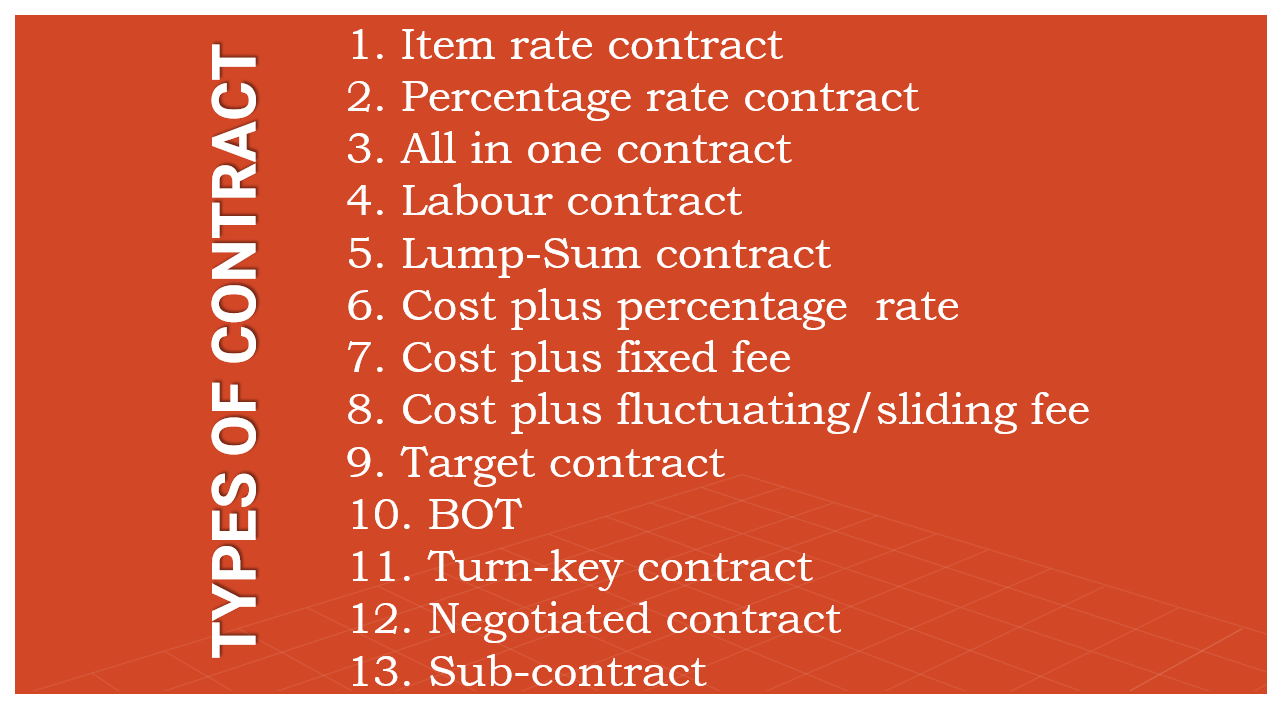1. Item rate contract
- This is also known as Unit price contract.
- In this contract, contractor quotes his rates for per unit of each item of construction.
- Bill of quantities is prepared as accurately as possible.
- Certain reasonable variations in the quantities being accepted by both the parties.
- Most of the public works are carried out under this form of the contract.
2. Percentage rate contract
- Department draws up the schedule of items according to the description of items sanctioned in the estimate with the quantities, units, rates and amounts shown therein.
- Department fix up the rates of different items in tender.
- Contractors are offered to carry out the work as per the rates shown in bill of quantities of tender or percentage above or below the rates indicated in the bill.
- There is no possibility of tampering or manipulating with the rates by contractor.
- As contractors are not required to quote their own rates for an individual items, the overwriting and erasing of rates can be avoided.
3. All in contract
- Its a rare form of contract but considered first because, the owner ceases to be the promoter and delegates a large firm or consortium/association to perform both, design and construction.
- This type of contract is suitable for some exceptional works and is rarely adopted for normal works.
- The work most suited for this type of contract are industrial facilities where firms are in market with their patented processing plants.
4. Labour contract
- When the owner is in the position to purchase the required materials himself, then he invites tenders only for the labour work.
- The contractor put up their rates for the labour per unit execution of each item.
- These rates includes the use of contractor’s plant and equipment, all necessary false-work, contractor’s supervision and contractor’s profit.
- The overall responsibility of the work is of the contractor.
- Owner has to see that the necessary materials are brought on site as per required.
- The Owner has also to keep watch that there no wastage of materials.
- Usually, the work done in this contract is of superior quality since materials of better quality are used and there is no mischief in the proportion of mortar, concrete, etc.
5. Lump – Sum contract
- It is the oldest type of contract and is still popular in some countries.
- Contractors are required to quote a fixed sum for execution of a work in all respects (according to drawing, design and specifications supplied to them with the tender within the required time).
- Schedule Of Rates (SOR) is also provided to the contractors to workout the cost of extra items.
- No payment can be recovered by the contractor until the whole is completed.
- There is no intermediate payment is made to the contractor.
6. Cost Plus Percentage Rate Contract
- In this type of contract, the contractor is paid the actual cost of the work plus an agreed percentage in addition to allow for profit.
- An agreement is prepared with all the conditions of contract in advance.
- Contractor arranges material and labour at his cost and keeps proper accounting.
- Contractor is paid by the owner the whole cost together with some agreed percentage.
- This kind of contracts are generally adopted when when the conditions are such that the labour and material costs are liable to fluctuate.
- It has a merit that the contracts can quickly be drawn up and agreed and also work of an urgent nature put in hand and completed without any delay.
7. Cost Plus Fixed Fee Contract
- The contractor is paid by the owner with an agreed fixed lump sum amount over and above the actual cost of the work.
- Fee doesn’t vary with the cost of the work as in case of cost plus percentage rate contract.
8. Cost plus fluctuating/sliding fee contract
- The contractor is paid the actual cost by the owner of contract plus an amount of fee inversely variable according to the increase or decrease of estimated cost agreed first by both the parties.
- Higher the actual cost, lower will be the value of fee.
- The contractor shall not try to increase the actual cost of the work as in case of ‘cost plus percentage rates’ or shall not be indifferent to in case of ‘cost plus fixed fee contract’ because the interest of contractor is totally involved with variations in the actual cost.
- The actual cost is thus lower and lower so both the owner and contractor will be benefited.
9. Target Contract
- The contractor is paid on a cost plus percentage basis of work performed under this contract, and in addition he receive a percentage plus or minus on saving of excess effected against the agreed estimate of total cost.
10. Build-Operate-Transfer (BOT)
- The contractor undertakes the design, finance, construct, operate and maintain the works for a concession in considerations of the exercise or to enjoy the rights, powers, benefits, privilege, authorities and entitlements including the amount receivable from the collection of charges levied on the beneficiaries who use the work and in some cases annuity payment each year.
- For example, in case of a road or bridge, the contractor constructs the structure and is entitled to collect toll from the road user for the concession period.
11. Turn key contract
- It sometimes happens that the owner contemplating a construction project desires to deal with only one party for all services, both engineering and construction, in connection with the work.
- offers are invited from specialised contractors for all planning, design, specifications, estimations, construction and supervision under one contract on competitive basis.
12. Negotiated contract
- When work is awarded on contract by mutual negotiation between the parties without call of tender.
- The parties selected being always reliable and financially sound, it ensures uninterrupted work with less chance of dispute.
13. Sub-contract
- Its an agreement between two contractors (the sub contractor and the main contractor), in which the sub contractor undertakes to carry out for the main contractor a particular portion of the work which main contractor has undertaken from the owner.
- The main contractor is responsible for the contract, product and payment of his subcontractor.
- The owner’s claims for damages are to be made against the main contractor.
- No claims for damage can be done against the owner by the subcontractor.
Please follow and like us:


